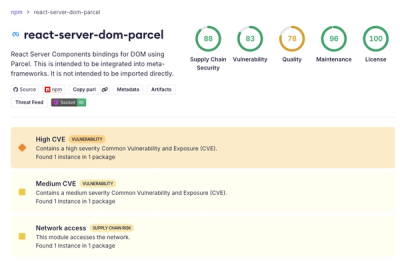
Security News
Deno 2.6 + Socket: Supply Chain Defense In Your CLI
Deno 2.6 introduces deno audit with a new --socket flag that plugs directly into Socket to bring supply chain security checks into the Deno CLI.
react-keyboard-hooks
Advanced tools

React Hooks for keyboard inputs with Typescript
There is a ton of packages that do something very similar, but aren't up to date for today's Typescript & Server-Side Rendering world.
Use these hooks if you want an easy way to add keyboard inputs to your application.
Compatible with React 16.8 and newer.
Does not support Internet Explorer for certain special keys such as Escape. If someone wants to add a map for the old key values feel free to create a PR, but I don't think IE is worth the time anymore.
To install the package (assuming you have React installed already):
npm install react-keyboard-hooks
# or
yarn install react-keyboard-hooks
Look up key names on the MDN web docs. That is the only parameter you need!
Note: regular unicode keys (ex. the alphabet) are the exact same, even though they aren't listed on the MDN docs.
const isKeyDown = useKey('Enter')
# or
useKey('Enter', callbackFn)
# or both
const isKeyDown = useKey('Enter', callbackFn)
the useKey hook takes a key value as a string, and returns a boolean if the key is currently pressed/down or not.
Optionally you can use a callback function that runs on the key down instead.
Example:
import React from 'react'
import { useKey } from 'react-keyboard-hooks'
const Example: React.FC = () => {
const isKeyDown = useKey('Enter')
if (isKeyDown) {
console.log('key is down')
}
if (!isKeyDown) {
console.log('key is up')
}
return <div>{isKeyDown ? 'down' : 'up'}</div>
}
Callback Example:
import React, { useState } from 'react'
import { useKey } from 'react-keyboard-hooks'
const Example: React.FC = () => {
const [keyPresses, setKeyPresses] = useState(0)
const callbackFn = () => {
console.log('key is down')
setKeyPresses((previousPresses) => (previousPresses += 1))
}
useKey('Enter', callbackFn)
return <div>{keyPresses}</div>
}
const isAnyKeyDown = useAnyKeys(['Enter', 'Tab', 'y'])
# or
useAnyKeys(['Enter', 'Tab', 'y'], callbackFn)
# or both
const isAnyKeyDown = useAnyKeys(['Enter', 'Tab', 'y'], callbackFn)
the useAnyKeys hook takes an array of key values (as strings) and returns true if any of the keys are currently pressed.
Optionally you can use a callback function that runs if any of the keys down instead.
Note: callback doesn't run multiple times if multiple keys are down at the same time.
Example:
import React from 'react'
import { useKeys } from 'react-keyboard-hooks'
const Example: React.FC = () => {
const isAnyKeyDown = useAnyKeys(['Enter', 'Tab', 'y'])
if (isAnyKeyDown) {
console.log('at least one key is down')
}
if (!isAnyKeyDown) {
console.log('all keys are up')
}
return <div>{isAnyKeyDown ? 'down' : 'up'}</div>
}
Callback Example:
import React, { useState } from 'react'
import { useAnyKeys } from 'react-keyboard-hooks'
const Example: React.FC = () => {
const [keyPresses, setKeyPresses] = useState(0)
const callbackFn = () => {
console.log('at least one key is down')
setKeyPresses((previousPresses) => (previousPresses += 1))
}
useAnyKeys(['Enter', 'Tab', 'y'], callbackFn)
return <div>{keyPresses}</div>
}
const allKeyDown = useAllKeys(['Enter', 'Tab', 'y'])
# or
useAllKeys(['Enter', 'Tab', 'y'], callbackFn)
# or both
const allKeyDown = useAllKeys(['Enter', 'Tab', 'y'], callbackFn)
the useAllKeys hook takes an array of key values (as strings) and returns true if all of the keys are currently pressed.
Optionally you can use a callback function that runs if all of the keys are down instead.
Example:
import React from 'react'
import { useKeys } from 'react-keyboard-hooks'
const Example: React.FC = () => {
const allKeysDown = useAllKeys(['Enter', 'Tab', 'y'])
if (allKeysDown) {
console.log('all keys are down')
}
if (!allKeysDown) {
console.log('at least one key is up')
}
return <div>{allKeysDown ? 'down' : 'up'}</div>
}
Callback Example:
import React, { useState } from 'react'
import { useAllKeys } from 'react-keyboard-hooks'
const Example: React.FC = () => {
const [keyPresses, setKeyPresses] = useState(0)
const callbackFn = () => {
console.log('all keys are down')
setKeyPresses((previousPresses) => (previousPresses += 1))
}
useAllKeys(['Enter', 'Tab', 'y'], callbackFn)
return <div>{keyPresses}</div>
}
const keys = useKeys(['Enter', 'Tab', 'y'])
the useKeys hook takes an array of key values (as strings) and returns an object with each key as the key (heh) and the current down/up value as a boolean.
Useful if you want more complicated logic with keypresses, or if you want to use a lot of keys at once (as useKey makes an event listener for each hook)
Example:
import React from 'react'
import { useKeys } from 'react-keyboard-hooks'
const Example: React.FC = () => {
const keys = useKeys(['Enter', 'Tab', 'y'])
if (keys.Enter) {
console.log('Enter key is pressed')
}
if (keys.Tab) {
console.log('Tab key is pressed')
}
return <div>{keys.y ? 'y is down' : 'y is up'}</div>
}
FAQs
simple react ts keyboard inputs
We found that react-keyboard-hooks demonstrated a not healthy version release cadence and project activity because the last version was released a year ago. It has 1 open source maintainer collaborating on the project.
Did you know?

Socket for GitHub automatically highlights issues in each pull request and monitors the health of all your open source dependencies. Discover the contents of your packages and block harmful activity before you install or update your dependencies.

Security News
Deno 2.6 introduces deno audit with a new --socket flag that plugs directly into Socket to bring supply chain security checks into the Deno CLI.

Security News
New DoS and source code exposure bugs in React Server Components and Next.js: what’s affected and how to update safely.

Security News
Socket CEO Feross Aboukhadijeh joins Software Engineering Daily to discuss modern software supply chain attacks and rising AI-driven security risks.